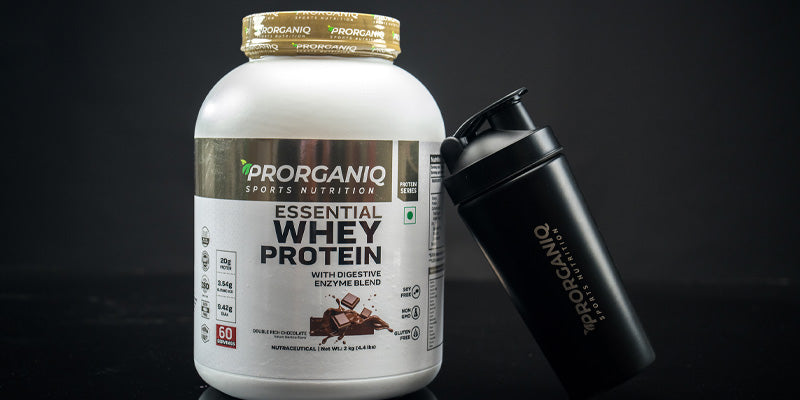What is Whey Protein? A Comprehensive Guide
Whey protein is a popular dietary supplement that has gained significant traction among athletes, bodybuilders, and individuals seeking to improve their overall health and wellness.
It is a high-quality protein source derived from the liquid byproduct of cheese production, containing all nine essential amino acids required by the human body.
One of the primary benefits of whey protein is its high bioavailability and rapid absorption rate, which enables the body to quickly utilize the nutrients for muscle growth and repair.
Additionally, whey protein boasts immune-boosting properties as it contains various bioactive compounds, such as immunoglobulins, lactoferrin, and glycomacropeptides, which aid in maintaining overall health.
What is Whey Protein?
Whey protein is a high-quality protein derived from milk during the cheese-making process. It is a complete protein containing all essential amino acids, which are the building blocks of the body's tissues, organs, and muscles.
Whey protein is often used as a nutritional supplement due to its numerous health benefits, including muscle growth, recovery, and overall health improvement.
The composition of whey protein varies depending on the specific type. However, on average, it consists of around 80% protein, a small amount of fats, and trace amounts of carbohydrates.
In addition, whey protein is rich in branched-chain amino acids (BCAAs)—leucine, isoleucine, and valine—which play essential roles in muscle repair and growth.
Types of Whey Protein
There are three main types of whey protein, each with different processing methods and nutritional profiles. These include:
- Whey Protein Concentrate (WPC): This is the least processed form, containing a protein content ranging from 30% to 89%. WPC retains more lactose, fats, and carbohydrates compared to other forms of whey protein but is typically less expensive.
- Whey Protein Isolate (WPI): Isolate undergoes further filtration, removing most lactose, fats, and carbohydrates. As a result, WPI contains 90% or more protein content and tends to be slightly more expensive than WPC.
- Whey Protein Hydrolysate (WPH): Hydrolysate undergoes additional processing, breaking down protein chains into smaller peptides for easier digestion and absorption by the body. WPH is the most expensive of the three types of whey protein and often used in medical protein supplements or specialized sports nutrition products.
The selection of the appropriate type of whey protein depends on an individual's dietary preferences, health goals, and budget. Regardless of the choice, the consumption of whey protein can contribute positively to muscle growth, recovery, and overall health.
Whey Protein Usage
In Supplements
Whey protein is a popular ingredient in supplements aimed at promoting muscle growth, aiding in recovery, and weight management. It is derived from milk during the cheese-making process and boasts a high biological value due to containing all essential amino acids. The two most common forms are:
Many consumers prefer whey protein because of its rapid absorption rate, aiding in quicker muscle recovery post-workout. Here is a brief overview of the benefits:
| Benefit | Description |
|---|---|
| Muscle Growth | High leucine content in whey protein stimulates protein synthesis and supports muscle growth. |
| Recovery | Faster protein absorption enables quicker repair of muscle tissue damaged during workouts. |
| Weight Management | Protein-rich diets contribute to increased satiety and, consequently, reduced calorie intake. |
Consumer Guide
Selecting the Right Whey Protein
When choosing a whey protein supplement, consider the following factors:
- Type of whey protein: Whey protein comes in three main forms: concentrate, isolate, and hydrolysate. Concentrate has a lower protein content and more fat and lactose. Isolate is more processed, resulting in a higher protein content with less fat and lactose. Hydrolysate is pre-digested, allowing for faster absorption.
- Quality assurance: Look for a reputable brand that has undergone third-party testing to ensure product quality and accuracy of labeling.
- Cost: Compare the cost per serving, taking into account the amount of protein per serving. The most affordable option may not always be the best value for money if it has a lower protein content.
- Flavors and mixability: Choose a flavor you enjoy and a product that mixes well without clumping.
- Additional ingredients: Some whey protein products contain added vitamins, minerals, or other functional ingredients.
FAQs About Whey Protein
What is whey protein?
Whey protein is a byproduct of cheese production, derived from the liquid portion of milk that separates during the process. It is a complete protein containing all nine essential amino acids, making it a popular choice for athletes, bodybuilders, and anyone looking to increase their protein intake.
Why is it popular?
Whey protein has become a staple in the fitness community due to its quick absorption rate, which helps promote muscle growth and recovery. Additionally, it is low in lactose, making it an ideal option for those who are lactose intolerant.
How is whey protein consumed?
Whey protein is commonly available in powder form and can be mixed with water, milk, or other liquids to create protein shakes. It can also be incorporated into recipes, such as protein bars and baked goods, to boost protein content.
Is it safe to consume whey protein?
Whey protein is generally considered safe when consumed in appropriate amounts, according to individual needs and goals. However, it is crucial to consult with a healthcare professional, especially if you have existing health conditions or are pregnant or nursing.
Can whey protein cause allergies?
Since whey protein is derived from milk, those who are allergic to milk protein may need to avoid it. Additionally, some people may experience digestive discomfort, such as bloating or gas, if they consume too much or are sensitive to lactose in whey protein concentrate.


